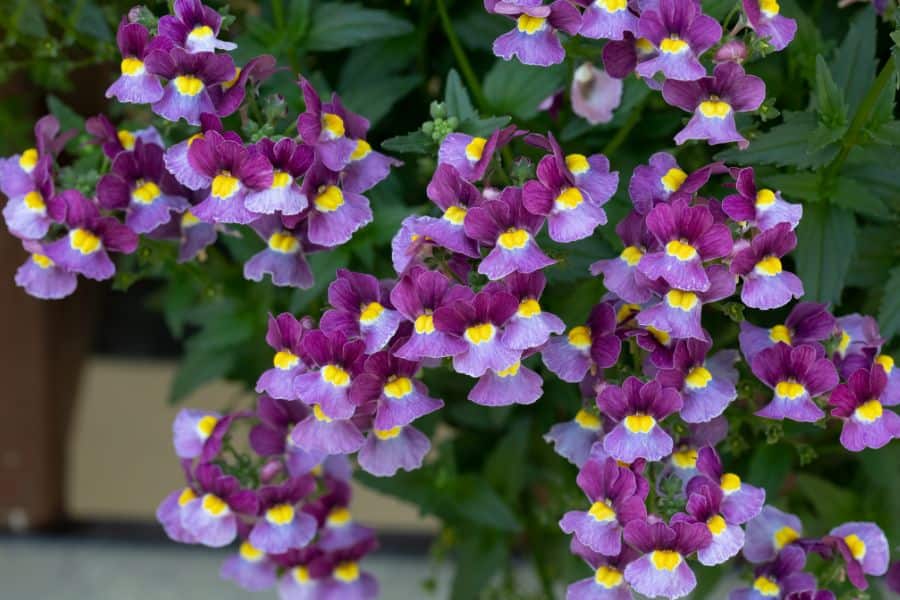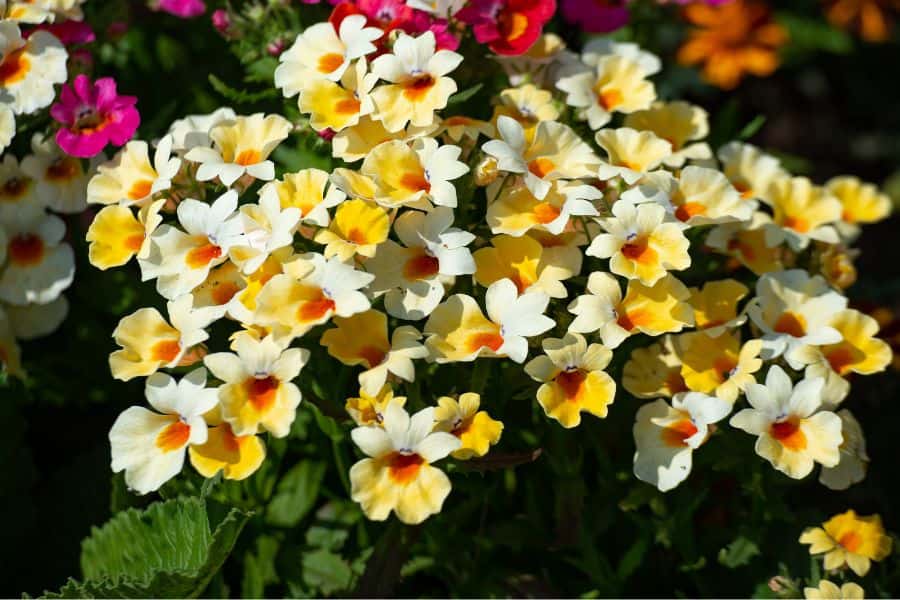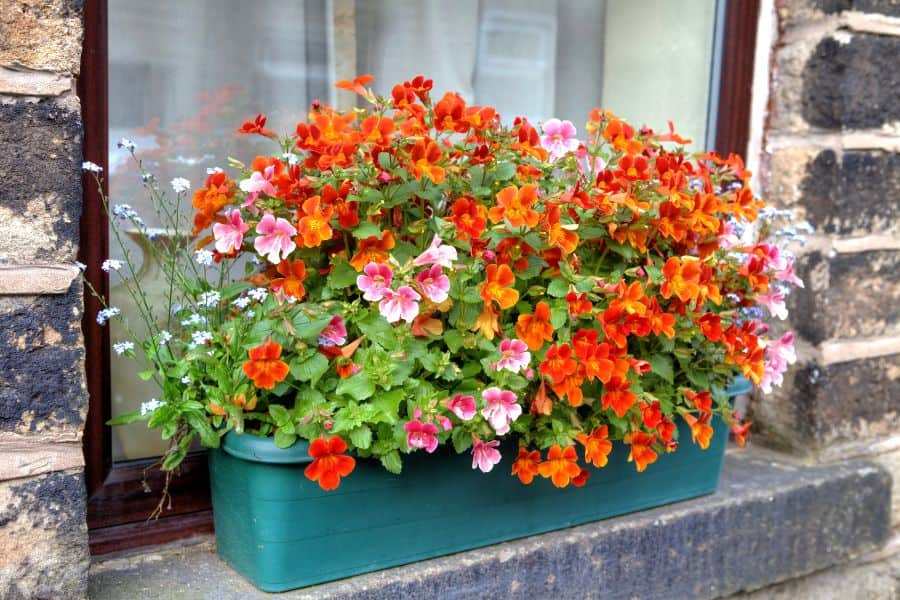Delicate yet dazzling, Nemesia stands among the most charming flowering plants to grace a garden. Native to South Africa and part of the figwort family (Scrophulariaceae), this genus bursts into a sea of color each spring and summer, producing clouds of small, vibrant blooms that seem to float above their soft green foliage. Their sweet, honey-like fragrance—often compared to vanilla or ripe fruit—intensifies in the evening, luring moths and other nighttime pollinators.
Nemesia contains over 50 known species, though Nemesia strumosa is the one most often found in gardens. This compact annual reaches about 20 inches tall and 12 inches wide, blanketing itself in blossoms of blue, pink, purple, white, and yellow. Whether tucked into containers, hanging baskets, or sunny borders, it offers a burst of color and fragrance that feels both joyful and effortless.

Our Selection of Nemesia
At Martin Garden Center, we are growing 4 varieties of Nemesia in 4″ containers. We also rely on our vendors to provide gorgeous and sweet-smelling Nemesia to keep our tables stocked. Normally, we provide 3-4 different varieties of Nemesia at any given time, from Spring to early Summer. We are growing the following varieties of Nemesia in 2025:
- Blue Bird
- Nesia Banana Swirl
- Nesia Inca
- Sunsatia Blood Orange
Growing and Caring For Nemesia
Nemesia thrives in areas with cool summers and mild winters, making it suitable for both garden beds and containers. When it comes to soil, Nemesia prefers well-draining soil that is enriched with organic matter. Ensure the soil is slightly acidic to neutral, with a pH level between 6 and 7. If your garden soil tends to be heavy or clayey, consider amending it with compost or well-rotted manure to improve drainage.
When planting Nemesia, choose a location that receives ample sunlight, preferably 6-8 hours of direct sunlight per day. While Nemesia can tolerate partial shade, it blooms best with sufficient light. Plant the seedlings or young plants after the last frost date in spring, or sow the seeds directly into the soil a few weeks before the expected frost-free date.
Watering is crucial for the healthy growth of Nemesia. Keep the soil consistently moist but not waterlogged. Aim to water deeply, allowing the water to penetrate the root zone. Regular watering is essential during dry spells or prolonged periods of heat. Avoid wetting the leaves when watering, as this can promote fungal diseases.
In order to promote healthy growth, consider fertilizing your Nemesia plants every 4-6 weeks during the growing season. Choose a balanced, water-soluble fertilizer and follow the instructions on the packaging for application rates. Nemesia are relatively disease and pest-resistant, but it’s still a good practice to monitor for any signs of pests and address them if necessary. Note that because Nemesia prefers cooler weather, its growth stagnates in hot summers. But, it returns in the fall … if it survives.
Leaves and Flowers
When it comes to the foliage of Nemesia, the leaves are typically lanceolate and deep green. The leaves are arranged opposite each other along the stems, giving the plant an organized and symmetrical appearance. The foliage is slightly sticky to the touch due to the presence of glandular hairs, which can deter certain pests. The leaves add a lush and verdant backdrop to the vibrant flowers, creating a visually appealing contrast in the garden.
Nemesia is known for its stunning flowers, which come in an array of colors, including pink, purple, white, yellow, and orange. The blossoms are often bi-colored or multi-colored, displaying intricate patterns and markings. As mentioned previously, these flowers are excellent for attracting pollinators.

Common Uses in Gardening and Landscaping
- Container Gardening: Nemesia’s compact and mounding growth habit is well-suited for container gardening. It can be planted in pots, hanging baskets, or window boxes, allowing gardeners to easily incorporate its beauty into small spaces, balconies, or patios.
- Ground Cover: Some varieties of Nemesia, particularly those with spreading habits, can be used as ground cover. Planting them in mass can create a colorful flower carpet that looks visually appealing and helps suppress weeds.
- Pollinator Attraction: Nemesia’s nectar-rich flowers attract pollinators such as bees and butterflies to the garden. This benefits the Nemesia plants themselves and contributes to the garden’s overall health and biodiversity by supporting pollinator populations.
- Cut Flowers: Nemesia flowers make delightful additions to cut flower arrangements. Their long-lasting blooms and sweet fragrance make them popular for creating bouquets, centerpieces, or floral displays for indoor enjoyment.
- Mixed Borders: Nemesia can used in mixed borders alongside other annuals, perennials, or shrubs. Its versatile color palette allows for creative combinations, providing gardeners endless possibilities for designing visually appealing landscapes.
- Fragrance Gardens: Nemesia’s sweet and pleasant fragrance makes it an excellent choice for gardens designed to stimulate the sense of smell. Planting Nemesia near seating areas or walkways allows gardeners to enjoy the delightful scent as they spend time outdoors.
- Low-Maintenance Landscaping: Nemesia is generally easy to care for, making it suitable for gardeners seeking low-maintenance landscaping options. Its adaptability and ability to thrive in various conditions make it an accessible choice for novice and experienced gardeners.

Frequently Asked Questions
Are Nemesia Deer Resistant?
Deer are known to feed on Nemesia, particularly when other preferred food sources are scarce. Nemesia is cultivated for its attractive flowers and fragrance, but its lack of resistance to deer browsing makes it susceptible to damage in areas with deer populations.
Why is My Nemesia Dying?
Nemesia thrives in well-draining soil, full sunlight, and moderate watering. Here are some common reasons why your plant may be struggling:
- Watering Issues: Nemesias prefers consistently moist but not waterlogged soil. Overwatering or underwatering can lead to problems. Ensure the soil is well-draining and water when the top inch of soil feels dry.
- Lack of Sunlight: Nemesias thrive in full sunlight. If your plant is not receiving enough light, it may become leggy or fail to produce flowers.
- Soil Quality: Nemesias prefers well-draining soil with organic matter. Poor soil quality can affect their growth. Consider amending the soil with compost or well-rotted manure.
- Temperature Stress: Nemesias are sensitive to extreme temperatures and particularly extreme heat in the South. They may show signs of stress if exposed to prolonged periods of heat or cold. Ensure they are planted in an environment with a suitable temperature range (e.g., morning sun in the South).
- Pests or Diseases: Check for signs of pests like aphids or diseases such as powdery mildew. Treat any infestations promptly with appropriate measures, such as insecticidal soap for pests or fungicides for diseases.
- Nutrient Deficiency: Lack of essential nutrients can lead to poor plant health. Consider fertilizing your plant with a balanced, water-soluble fertilizer according to the recommended dosage.
